The most important thing to know about knife sharpening is that there is no “best” way to sharpen a knife. There are tons of different sharpening techniques and tools, but that does not matter if you never sharpen your knives! The best way to sharpen is to find the technique that you actually use so that you do it regularly. It doesn’t matter if you have the latest and greatest sharpening gadget, if you never use it. In the long run it would be better to use a sharpener that may not produce as sharp an edge as long as you use it regularly.
The other important thing to remember is that it is easy to over think sharpening and obsess about getting an even sharper edge. It is always possible to get a knife sharper, but after a certain point you get diminishing returns. You will definitely notice the difference between a dull knife and a sharp knife as you will be able to cut things better and safer. It would be much harder to tell the difference between a sharp knife and a hella, wicked sharp knife. Most importantly it will make very little improvement in what you are cooking.
Knives should be sharpened regularly. Cutting through tough, fibrous material can dull a knife in one session. A knife’s point is a very thin strip of metal that can be bent to one side and when that happens your knife becomes dull. Using the metal steel that comes with most knife sets lets you bend or hone the edge closer to normal. Honing helps reshape the blade, but after a while the point will become rounded. In order to sharpen a round point you need to remove metal with an abrasive material. If you hack through bone or something tough like a coconut, you can end up with nicks in the blade. In that case, removal is probably best left to a professional.
A knife’s sharpness is defined by the angle at which the blade comes to a point. The knife is basically a wedge, and a wedge that is narrow and thin will have a much easier time slicing through something. The only problem with a thin and narrow wedge is that it is also weak. The sharper a knife’s point becomes, the thinner the metal at the point gets which means the knife will become duller quicker. The lesson here is that you want to find an angle that is narrow enough to be sharp, but wide enough to be strong. Aiming for between 30-45 degrees should give you a great knife for slicing. A 30 degree angle means that you want each side of the point to be angled in 15 degrees. I may have went on a bit about angles, but you shouldn’t worry about them too much. It is more important to get a consistent angle when you sharpen, rather than getting a precise angle. If you change the angle you are sharpening with at each pass of the knife, you are going to removing the point you just put in. The point will be more rounded than angled.
There are two basic categories for knife sharpeners, ones which hold your knife at a fixed angle as you sharpen and ones which rely on you holding the knife at the correct angle. The people at Smith’s just released a line of kitchen sharpeners and sent me a few. I already have an electric knife sharpener and water stone, so I am going to do a run down on the different styles. All of the sharpeners I am going to go over sharpen knifes really well, it is all about choosing which one is going to meet your needs the best…and actually use!
Fixed Angle
Pull Through Sharpeners – With this style of sharpener you hold your knife vertically and pull it through the slot. Each slot has two abrasive rods set at an angle which form a V. When you pull your knife through, they sharpen and shape the point of the knife. Depending on the aggressiveness of the abrasives used, you may need pull your knife through a number of times.
What to look for: You want the knife to pull through the sharpener smoothly.
Pros:
- Compact, easy to keep in reach and sharpen knifes regularly
- Cheap
- No special skills needed
- Holds the blade at the correct angle
Cons:
- There are a lot of bad versions out there, make sure you check the reviews for models you are interested in. The Smith’s brand sharpener worked great.
- Japanese knives need to be sharpened at a different angle and may not work.
- It can be slow to restore a very dull blade and may not be able to correct all defects.
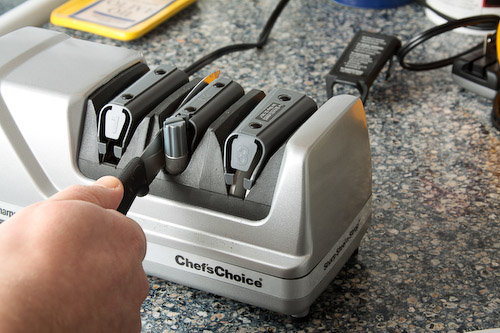
Electric Sharpener – Electric sharpeners are they same as the pull through sharpeners, except that abrasive is spinning inside the sharpener. These sharpeners work quickly, letting you bring a dull knife back to sharpness quickly. This also means a bad sharpener can ruin a knife quickly. In general, you usually get what you pay for with an electric sharpener.
What to look for: You want a machine that is relatively quiet and operates smoothly. The width of some machines may make it impossible to sharpen the heel of the knife.
Pros:
- Can quickly restore a very dull blade
- No special skills required
- Holds the blade at the correct angle
Cons:
- Bulky, needs to be plugged in
- A good one can be expensive
- Japanese knives need to be sharpened at a different angle and may not work.
Free-form Sharpeners:
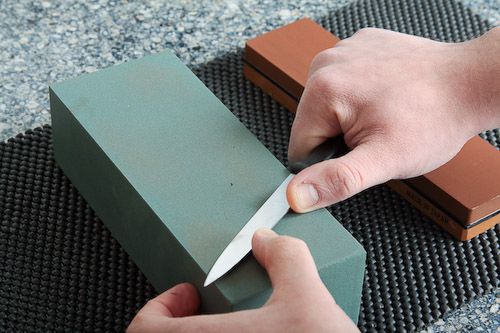
Water Stones – Water stones are big blocks of abrasive material and come in a variety of abrasiveness. They can be tough to use at first. In order to get good results you need to hold the knife at a constant angle as you drag it across the different stones. There are guides which you can buy to help you get the correct angle. You will need at least two stones, a coarse and fine one. The real benefit it that you are able to set any angle you want…if you have the skill.
What to look for: Check out woodworking catalogs and websites. Sharpness is even more important to woodworkers.
Pros:
- Lots of control over how the knife is sharpened, it is easy to just touch up the heel of the knife if it is dull or damaged
- Use any angle you like, great for giving Japanese knives a sharp point and cleavers a strong one
- Looks cool!
- Modestly expensive
Cons:
- Can take a long time and requires patience
- Messy and takes up a bunch of space, not great to leave out on the counter
- Takes a bit of practice to do correctly
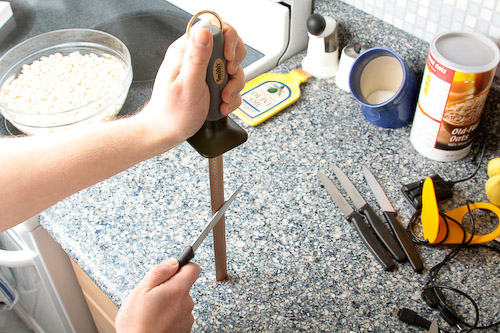
Abrasive Steels / Sharpening Rod – These are like traditional steels, except they are abrasive so instead of just reshaping the point, they sharpen it too. There are two different types of abrasives available, diamond and ceramic. The diamond abrasives are more aggressive than ceramic. In order to use the steel correctly, you have the hold your knife at a constant angle as you bring it down the steel. A couple swipes before each time you use your knives will keep your blades in good condition. You have to pay attention while you do this, but it looks cool.
Pros:
- Cheap
- The most compact, easy to store and use each time before you cut
- Can sharpen at any angle, including Japanese knifes
- Great for maintaining an edge which is already sharp
Cons:
- Each sharpening rod only comes in one abrasiveness
- Will take a long time to make a dull knife sharp
- Takes less skill than water stones, but you still need to hold the knife at the correct angle
Here is the rundown:
- Pull Through Manual Sharpeners – great for keeping knives in good condition sharp. It is easy to keep close at hand and use regularly. It can not fix badly damaged or dull knives.
- Electric Sharpeners – can quickly sharpen a knife. Some sharpeners can even regrind the large blade of the knife, not just the point. This allows them to repair damaged and very dull knives. They are bulkier though and needed to be plugged in, which may make you less likely to use them regularly.
- Water Stones – if you know how to use a water stone and have the time, they will give you the best edge possible. They give you control over the angle and allow you to focus on one portion of the blade. You can fix damaged and very dull blades. However water stones take a bit of skill to use. They are messy and take awhile to setup, making them tough for everyday use.
- Sharpening Rods – great for maintaining a blade, they can sharpen and align the blade. They are generally not very abrasive, making them ideal for daily use, but not good for sharpening a very dull blade. They do not have a fixed angle, allowing them to be used with Japanese knifes, but they do take a bit of practice to get good at.
The ideal solution is to probably have two sharpeners, one for everyday use to maintain the sharpness of a blade and then a more advance one to restore the sharpness of a blade. An electric sharpener and a sharpening rod would be a great combo. You could easily get away with just an electric sharpener if you can keep it on your counter and use it regularly.
If you read through all this and are confused, get a manual pull through sharpener. If you read through this and understood it all, get a high end electric sharpener because they work great.
There is of course tons of great information about sharpening out there on the web:
- Knife Maintenance and Sharpening
- A Primer on Knife Sharpening
- An Awesome Video on Sharpening from the esteemed Tom Mylan
If you are looking to buy a sharpener, the Smith’s Edge sharpeners that I tried worked really well. They produced a very sharp edge and they are affordable. If you don’t have a sharpener, either of the pull through sharpeners is $12 well spent. The sharpening rods are a great way to maintain the edge you just sharpened. You can also not go wrong with the Chef’s Choice line of electric sharpeners.
I sharpened 7 different knives with different sharpeners and I will do a round-up in a little on how each sharpener worked.
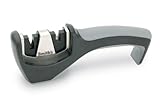



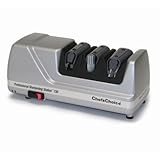
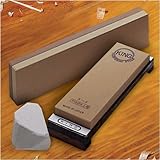
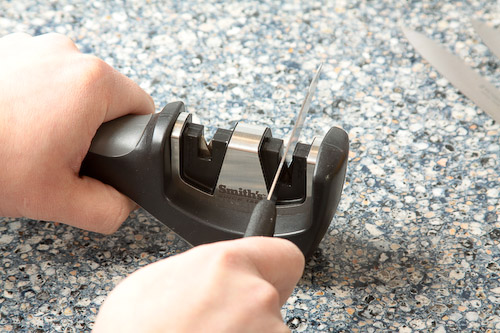
Thanks for the great information. I think I will start with the manual, but first take all my knives to be professionally sharpened, and then just keep up.
Is it true that letting a knife soak in water causes the blade to loose it sharpness?
There is some truth to it. If you have a Carbon Steel knife, the edge can rust which will dull. Stainless steel, which must knives are made out of these days, can rust over time too… I think. It may not be as big a problem though.
After living with dull knives your 18 years at home..it makes complete sense you would want only sharp knives for your kitchen…..I will try to sharpen knives before your and Carolyn’s nest visit….
Thanks Dad!